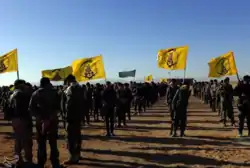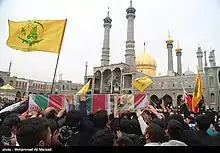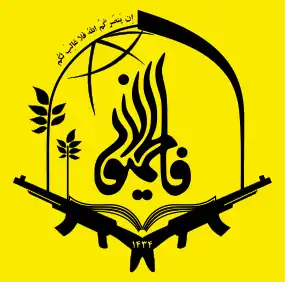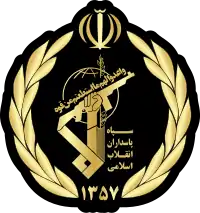Liwa Fatemiyoun
Liwa Fatemiyoun (Arabic: لِوَاء الْفَاطِمِيُّوْن, romanized: Liwā’ al-Fāṭimiyyūn, Persian/Dari: لواء فاطمیون or لشکر فاطمیون), literally "Fatimid Banner", also known as Fatemiyoun Division, Fatemiyoun Brigade,[3] or Hezbollah Afghanistan,[6] is an Afghan Shia militia formed in 2014 to fight in Syria on the side of the Syrian government.
It is funded, trained, and equipped by the Islamic Revolutionary Guard Corps (IRGC), and fights under the command of Iranian officers.[4] However, the group has denied direct Iranian government involvement in its activities.[4] By late 2017, the unit numbered between 10,000–20,000 fighters.[3] According to Zohair Mojahed, a cultural official in the group, the group has suffered 2,000 killed and 8,000 wounded in combat in Syria from its establishment up to the end of 2017.[21]
History
The core of Liwaa Fatemiyoun is constituted of the fighters of the Shia militia group Muhammad Army (سپاه محمد) which was active during the Soviet–Afghan War and against the Taliban, until its collapse after the Invasion of Afghanistan, as well as the Abuzar Brigade, an all-Afghan Shia militia group who voluntarily fought in the Iran–Iraq War. During the Iran–Iraq war, these fighters were stationed in the mountainous areas of Loolan and Navcheh in the northwestern Iran, as they had experience in mountain warfare and irregular warfare during the war against the Soviets.[22][23][24]
Reports of pro-government Afghan fighters date back to October 2012.[4] They originally fought in the Iraqi Abu Fadl al-Abbas Brigade before eventually becoming a distinct brigade in 2014.[25]
The group's official purpose is the defense of the shrine of Zaynab bint Ali, the granddaughter of Prophet Muhammad. However, it has fought on active frontlines around Daraa, Aleppo, and Palmyra. In October 2014, three fighters were captured by the rebel Islamic Front. Their fates are unknown.[26] On 7 May 2015, Iran commemorated 49 fighters of the group who were killed.[27] According to Spiegel Online, 700 members of the group are believed to have been killed in combat around Daraa and Aleppo as of June 2015.[28] The Washington Institute estimated at least 255 casualties between January 19, 2012 and March 8, 2016.[29] In March 2016, they fought in the recapture of Palmyra from the Islamic State.[30]

In August 2016, Iranian official Qurban Ghalambor was arrested by the Afghan government for recruiting fighters for the brigade.[31]
.jpg.webp)
In 2017, the unit helped countering a major rebel offensive in northern Hama Governorate,[14] and later aided a pro-government offensive in the Syrian Desert that aimed at reaching the Iraqi border.[15] In course of the latter campaign, Mohammad Hosseini (also known as "Salman") was killed as he stepped on an anti-personnel mine. Hosseini had served as the intelligence chief of Liwa Fatemiyoun's Hazrat-e Fatemeh Zahra Brigade.[32] Following the successful conclusion of this offensive, the Liwa Fatemiyoun took part in the campaign to capture all of central Syria from ISIL. Anwar Yawri, another commander of Liwa Fatemiyoun, was killed during these operations.[16] As of July, 2017, the militia lost some 600 men fighting in Syria.[33] The unit later took part in the Eastern Syria campaign (September–December 2017), and helped to break ISIL's siege on Deir ez-Zor.[3]
On 21 November 2017, Iran declared victory over ISIL, and subsequently started to downsize Liwa Fatemiyoun. The first troops to be demobilized were the youngest and oldest, as well as those who had exhibited problematic behavior such as indiscipline. The demobilized fighters were sent back to Iran to return to their families and civilian life.[3]
Organization, supplies and equipment
Liwa Fatemiyoun is led by IRGC commanders and supplied by the Iranian military,[3][31] while its troops are recruited from the approximately 3 million Afghans in Iran,[3][31][5]as well as Afghan refugees already residing in Syria.[6] The recruits are typically Hazara, an ethnic group from central Afghanistan.[6][4][31] The Iranian recruiters for Liwa Fatemiyoun are usually members of the Basij.[34]

The Afghans are promised Iranian citizenship and salaries of $500–$800 per month in return for fighting (usually a 3-month-long deployment to Syria).[3][20][4][25] Many are refugees[20] and some criminals who choose recruitment over imprisonment or deportation,[25][28][26] though the Iranian government generally claims that they are religiously motivated volunteers.[3][34] Iranian media has claimed that the Iranian military provides Liwa Fatemiyoun fighters and their IRGC officers with Hashish to raise their morale.[35]
Though some Afghan sub-commanders of Liwa Fatemiyoun are veterans of several wars, including the Iran–Iraq War and the Afghan Civil War (1996–2001),[3] new recruits of the unit generally lack combat experience.[5] The recruits are given just a few weeks of training, armed, and flown to Syria via the Iraq–Syria–Iran air bridge. These soldiers are used as shock troopers, spearheading numerous important pro-government offensives alongside Iranian, Iraqi, and Hezbollah troops. Most of them operate as light infantry, although some receive more thorough training and can work as tank crews.[36] Parts of Liwa Fatemiyoun have been trained by the Russian Armed Forces.[3] As the unit is often used in those war zones where the most intense fighting takes place[3] despite its sometimes inadequate training,[5] observers believe that Liwa Fatemiyoun fighters often act as "cannon fodder".[3][5]
Accusations of war crimes
According to Human Rights Watch, Liwa Fatemiyoun has recruited child soldiers, some of whom were as young as 14.[34] Pro-Syrian opposition media has claimed, based on photographs, that Liwa Fatemiyoun fighters use Sarin gas grenades.[37]
References
- "Iran mourns 7 Afghans killed fighting for Damascus ally". Daily Star Lebanon. Retrieved 7 May 2015.
- yalibnan. "Top Iranian Guards commander, several fighters killed in Syria". Retrieved 6 May 2016.
- Ahmad Shuja Jamal (13 February 2018). "Mission Accomplished? What's Next for Iran's Afghan Fighters in Syria". War on the Rocks. Retrieved 4 August 2018.
- "Iran's Afghan Shiite Fighters in Syria". Washington Institute for Near East Policy. Retrieved 9 May 2015.
- AFPC (2017), p. 340.
- "Liwa al-Fatemiyoun". Jihad Intel. Retrieved 4 August 2018.
- "Syria rebel group denies releasing Afghan prisoners". 23 February 2016.
- Sohranas. "More than 50 air raids carried out on Jeser al-Shagour, and the violent clashes continue around hills in Frikah village and al-Alawin checkpoint". Syrian Observatory For Human Rights. Retrieved 9 May 2015.
- Leith Fadel (2 November 2015). "Syrian Army and Hezbollah Make Huge Gains in Southern Aleppo: Military Operations Begin in Al-Hadher". Al-Masdar News. Retrieved 29 August 2016.
- Amir Toumaj (3 August 2016). "Iranian military involvement in the battle for Aleppo". The Long War Journal. Retrieved 29 August 2016.
- "Iran Sent Them to Syria. Now Afghan Fighters Are a Worry at Home". New York Times. 11 November 2017.
Not only did Iran send smaller units of the Fatemiyoun to cross Syrian borders and fight in Yemen
- "After ISIS, Fatemiyoun Vows to Fight with "Axis of Resistance" to Destroy Israel". Middle East Institute.
- Christoph Reuter. American Fury: The Truth About the Russian Deaths in Syria: Hundreds of Russian soldiers are alleged to have died in U.S. airstrikes at the beginning of February. Reporting by DER SPIEGEL shows that events were likely very different. Der Spiegel, 2 March 2018.
- Amir Toumaj (2 April 2017). "Qassem Soleimani reportedly spotted in Syria's Hama province". Long War Journal. Retrieved 3 April 2017.
- Amir Toumaj (14 June 2017). "Qassem Soleimani allegedly spotted in Syria near the Iraqi border". Long War Journal. Retrieved 15 June 2017.
- "Including a Commander, new dead of Fatimioun militia in Syria". Al-Dorar Al-Shamia. 27 July 2017. Archived from the original on 1 August 2017. Retrieved 28 August 2017.
- "UN aid convoy to make fresh attempt to reach battered Syrian rebel enclave". www.yahoo.com.
- "Military commander in the Southern Front illustrates latest developments of Daraa". 22 June 2018. Retrieved 18 July 2018.
- Joe Truzman (14 February 2020). "IRGC trained militias suffer losses in northwest Syria". Long War Journal. Retrieved 17 February 2020.
- Mashal, Mujib; Faizi, Fatima (November 11, 2017). "Iran Sent Them to Syria. Now Afghan Fighters Are a Worry at Home" – via NYTimes.com.
- "More than 2,000 Afghans killed in Syria fighting for Bashar al-Assad: Official". Middle East Eye.
- mashreghnews.ir, مشرق نیوز : آخرین اخبار ایران و جهان. "تیپ فاطمیون، لشکر شد".
- "لشکر "فاطميون" چگونه شکل گرفت؟ - سرلشکرقاسم سلیمانی - Qasem Soleimani". Archived from the original on 2016-10-07. Retrieved 2016-07-18.
- "روایت تیپ 300 نفره "ابوذر" که همگی افغانستانی بودند - FarsNews Agency".
- "Afghans in Syria: Ayatollah's soldiers serving Assad". 5 November 2014. Retrieved 6 May 2016.
- War Is Boring. "Iran Is Forcing Poor Afghans to Fight and Die in Syria". Medium. Archived from the original on 7 October 2016. Retrieved 6 May 2016.
- "Sami on Twitter". Twitter. Retrieved 9 May 2015.
- Reuter, Christopher (9 June 2015). "The Afghans Fighting Assad's War". Der Spiegel. Retrieved 10 June 2015.
- "Iranian Casualties in Syria and the Strategic Logic of Intervention". Washington Institute for Near East Policy. Retrieved 6 May 2016.
- Leith Fadel (21 March 2016). "Iranian special forces arrive in Palmyra to help liberate the city". Al-Masdar News. Retrieved 6 May 2016.
- Albin Szakola (29 August 2016). "Afghanistan arrests Iran official for recruiting Shiite fighters". NOW. Archived from the original on 1 February 2017.
- Amir Toumaj (7 June 2017). "Afghan Fatemiyoun Division operative killed near US base in southeastern Syria". Long War Journal. Retrieved 9 June 2017.
- Latifi, Ali M. (2017-06-30). "Opinion | How Iran Recruited Afghan Refugees to Fight Assad's War". The New York Times. ISSN 0362-4331. Retrieved 2019-11-06.
- "Iran: Afghan Children Recruited to Fight in Syria. Protection Gaps Increase Children's Vulnerability". Human Rights Watch. 1 October 2017. Retrieved 4 August 2018.
- "Iran has provided "cannabis" as motivation for the Afghan "Fatimioun Brigade" in Syria". Al-Dorar Al-Shamia. 7 August 2017. Archived from the original on 11 October 2017. Retrieved 17 July 2018.
- Fariba Sahraei. "Syria war: The Afghans sent by Iran to fight for Assad". BBC Persia. 15 April 2016.
- ""Fatimioun Brigade" in Syria have bombs containing sarin gas". Al-Dorar Al-Shamia. 7 September 2017. Archived from the original on 9 September 2017. Retrieved 4 August 2018.
Bibliography
- AFPC (2017). The World Almanac of Islamism 2017. Lanham, Maryland; London; New York City: Rowman & Littlefield. ISBN 978-1442273443.

